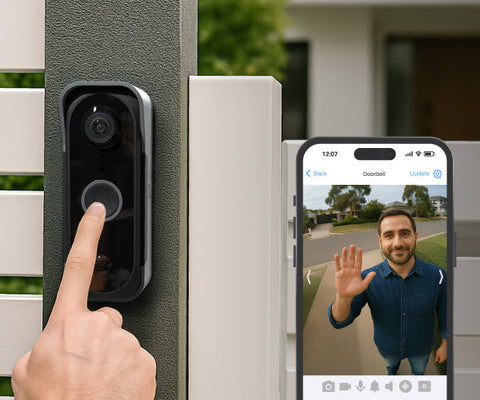If you're setting up a home security system for the first time, one of the most common questions is, “How many cameras do I actually need?” The answer depends on a few key factors, the size of your property, the layout, and what level of coverage you want.
In this guide, we’ll help you figure out the right number of cameras for your home or business. Whether you're securing a small flat in Brussels or a multi-level house in the suburbs of Lyon, the goal is the same: full visibility, smart coverage, and peace of mind.
Start with the Basics: Cover All Key Entry Points
The first priority is to monitor the places where someone could enter. These are typically:
- Front door
- Back door or garden entrance
- Ground-level windows
- Garage or side gate
Even small homes often have three to five possible entry points. You’ll want at least one camera per entrance — ideally with night vision and motion detection — so nothing goes unseen.
📌 Tip: Consider using a video doorbell for your front door, as it doubles as both a visitor camera and an intercom.
Indoor or Outdoor, Or Both?
Some people focus only on outdoor coverage, but indoor cameras have their place too. They’re especially helpful if:
- You have children or pets at home
- You want to monitor shared spaces while away
- You need evidence in case of a break-in
One camera in your main hallway, living room, or kitchen can help you keep track of activity without being invasive.
Property Size and Camera Count Recommendations
Here’s a general guide based on the type and size of your property:
| Property Type | Recommended Cameras |
|---|---|
| Small flat or apartment | 2 to 3 cameras (front door, main room, balcony or entry hall) |
| Standard semi-detached house | 4 to 6 cameras (front, back, garage, and a few inside) |
| Large home or rural property | 6 to 10+ cameras (full perimeter plus internal coverage) |
| Small business or storefront | 4 to 8 cameras (entrances, till area, stock room, exterior) |
Keep in mind that larger properties with multiple access points will require broader coverage, especially if you want to avoid blind spots.
Combine Different Camera Types
Swann systems are modular, so you can mix and match camera types depending on the area:
- Wireless cameras for flexible installation or rental properties
- Wired cameras for permanent coverage with 24/7 recording
- Pan & tilt cameras for wide-angle indoor areas
- Video doorbells for entryways and front porches
Explore our full range of wireless, wired, and smart doorbell solutions to create a system that fits your home perfectly.
Factor in Your Wi-Fi or Recorder Capacity
If you're using a wireless system, make sure your Wi-Fi can support the number of live streams and alerts. For wired systems, check how many channels your recorder supports:
- 4-channel systems support up to 4 cameras
- 8-channel systems support up to 8 cameras
- 16-channel systems are ideal for larger homes and businesses
📌 Tip: If you're unsure about your current capacity, check your recorder model or contact our support team for help.
Still Not Sure? Start Small and Expand Later
One of the best parts of using Swann systems is that you can start with a 2 or 4 camera setup and expand as needed. Add-on cameras are available for both wired and wireless setups, so you can build out your system over time.
Final Takeaway
You don’t need a dozen cameras to stay protected. What you need is the right number, in the right places, with the right features for your lifestyle.
From small flats to larger family homes, the key is visibility and smart placement. Think about your entrances, daily routines, and risk zones — then build your system around that.


